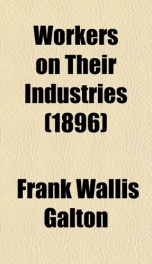workers on their industries

Purchase of this book includes free trial access to www.million-books.com where you can read more than a million books for free. This is an OCR edition with typos. Excerpt from book: DRESSMAKERS AND TAILORESSES. By Frances Hicks, Secretary of the Women's Trade Union Association. It is impossible in the short space at my disposal for this essay to deal adequately with the history of clothing. I am afraid that if I were to go into that subject, taking note of all the variations of race and climate, and of changes in fashion and custom, it would require a volume to itself. The study would, however, be a very interesting one, especially when we remember how frequently the characteristics of dress are inseparable from the strong personalities of history. We cannot think of Queen Elizabeth without her "ruff" and "hooped" skirt, or of Joan of Arc except as arrayed for battle ; and future generations will probably associate John Burns with a straw hat. Before the growth of large towns and cities with the development of commerce in England, clothes were mainly home-spun and home-made. Dressmaking is one of the industries that formerly belonged to the home, just as much as baking and washing, no matter what the occupation of the bread-winner might be. Baking day at home is now, in the towns, supplanted by the bake-houses; laundry work is becoming more and more a workshop or factory industry; the handloom has long been replaced by the weaving shed; and, while there is still much home-made clothing, a very large industrial class has already arisen devoted to the making of costumes and clothing in our city workshops and factories. Dressmaking is technically known as a business, just as tailoring is styled a trade. I believe that in the indefinable grades of our society, a business is thought to be more ladylike than atrade, and, indeed, next door to a profession. It is unnecessary for me to recount the reasons by which girls, who were formerly kept at home t...
Info about the book
Author:
Series:
Unknown
ISBN:
0805073396
Rating:
4/5 (2)Your rating:
0/5
Languge:
English
Users who have this book
Users who want this book
What readers are saying
What do you think? Write your own comment on this book!
write a commentif you like workers on their industries try:
Other books by this author
Do you want to read a book that interests you? It’s EASY!
Create an account and send a request for reading to other users on the Webpage of the book!


